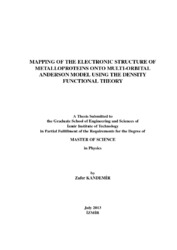Please use this identifier to cite or link to this item:
https://hdl.handle.net/11147/3626Full metadata record
| DC Field | Value | Language |
|---|---|---|
| dc.contributor.advisor | Bulut, Nejat | - |
| dc.contributor.author | Kandemir, Zafer | - |
| dc.date.accessioned | 2014-07-22T13:51:58Z | - |
| dc.date.available | 2014-07-22T13:51:58Z | - |
| dc.date.issued | 2013 | - |
| dc.identifier.uri | http://hdl.handle.net/11147/3626 | - |
| dc.description | Thesis (Master)--Izmir Institute of Technology, Physics, Izmir, 2013 | en_US |
| dc.description | Includes bibliographical references (leaves: 47-52) | en_US |
| dc.description | Text in English; Abstract: Turkish and English | en_US |
| dc.description | xi, 77 leaves | en_US |
| dc.description | Full text release delayed at author's request until 2016.08.26 | en_US |
| dc.description.abstract | In this thesis, an effective Haldane-Anderson model is constructed in order to describe the electronic properties of a system where a the transition-metal impurity atom is added into a semiconductor host material. Metalloenzymes and metalloproteins are proteins which contain a transition metal. Vitamin B12 is a metalloenzyme which contains a cobalt (Co) atom. The vitamin B12 exhibits semiconducting properties due to the presence of a semiconductor gap in the electronic density of states. Thus, we argue that the electronic properties of vitamin B12 can be studied within the framework of the Haldane- Anderson model. In this thesis, firstly, the electronic structure of vitamin B12, which is known as cyanocobalamin, is obtained by using the Density Functional Theory (DFT) via the Gaussian program. By using the DFT results, the energies of the host and the 3d orbitals, and the hybridization terms between them are calculated. The final Haldane- Anderson Hamiltonian is obtained by adding the onsite Coulomb repulsion at the impurity 3d orbitals. The Haldane-Anderson Hamiltonian which has been constructed in this way from the DFT results can be studied by using the exact techniques many-body physics such as quantum Monte Carlo. Perturbative mean-field treats can also be used to study this Hamiltonian. Hence, the DFT calculations presented in this thesis represent the first step of thorough investigation of metalloproteins using these techniques of many-body physics. | en_US |
| dc.language.iso | en | en_US |
| dc.publisher | Izmir Institute of Technology | en_US |
| dc.rights | info:eu-repo/semantics/openAccess | en_US |
| dc.subject.lcsh | Anderson model | en |
| dc.subject.lcsh | Density functionals | en |
| dc.subject.lcsh | Metalloproteins | en |
| dc.title | Mapping of the Electronic Structure of Metalloproteins Onto Multi-Orbital Anderson Model Using the Density Functional Theory | en_US |
| dc.type | Master Thesis | en_US |
| dc.institutionauthor | Kandemir, Zafer | - |
| dc.department | Thesis (Master)--İzmir Institute of Technology, Physics | en_US |
| dc.relation.publicationcategory | Tez | en_US |
| dc.identifier.wosquality | N/A | - |
| dc.identifier.scopusquality | N/A | - |
| item.languageiso639-1 | en | - |
| item.cerifentitytype | Publications | - |
| item.openairetype | Master Thesis | - |
| item.openairecristype | http://purl.org/coar/resource_type/c_18cf | - |
| item.fulltext | With Fulltext | - |
| item.grantfulltext | open | - |
| crisitem.author.dept | 01. Izmir Institute of Technology | - |
| Appears in Collections: | Master Degree / Yüksek Lisans Tezleri | |
Files in This Item:
| File | Description | Size | Format | |
|---|---|---|---|---|
| 10013875.pdf | MasterThesis | 3.67 MB | Adobe PDF |  View/Open |
CORE Recommender
Page view(s)
284
checked on Jun 16, 2025
Download(s)
194
checked on Jun 16, 2025
Google ScholarTM
Check
Items in GCRIS Repository are protected by copyright, with all rights reserved, unless otherwise indicated.